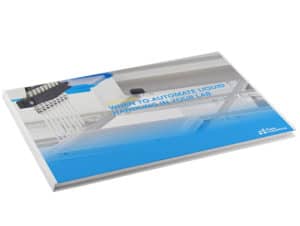Why lab automation
Are you here because you have asked yourself: why should I automate my lab?
Then we might be able to help.
The Challenges of manual lab work
One of the top reasons for choosing lab automation is simply that it relieves you of the challenges of your manual workload.
Manual lab work is tedious and puts heavy pressure on laboratory staff. They might spend hours doing repetitive work where they could otherwise do more valuable work, such as research or analysis, to increase throughput.
Moreover, working in a fixed position and doing the same arm movements throughout the day can cause serious work-related strain injuries. This can compromise the health of your staff and put your project behind its deadline.
Manual work also enhances the risk of human errors and contamination – especially when going from one step to the next in a workflow.
These are all some of the pains that an automation solution can easily relieve you of, and why lab automation is becoming an integral part of all types of laboratories.
And luckily, today there are automation solutions for labs of all shapes and sizes as user-friendliness and flexibility have become top priorities.
Do I need lab automation?
As new technological achievements emerge, so does the need to automate laboratories and get higher reproducibility, efficiency, and better working conditions. This is especially the case within pipetting.
Liquid handling robots are among the must-haves in lab automation and there are few things more strenuous and bothersome than manual pipetting.
In fact, there is a significant increase in the risk of developing musculoskeletal problems when pipetting for more than 300 hours a year. Assuming you work between 180 and 200 days a year, this is no more than 1-2 hours a day.[1]
Liquid handling robots can play a key role in many different workflows. Some of the applications that it typically covers are:
- PCR and qPCR
- Next Generation Sequencing
- ELISA sample preparation
- Normalization
- Dilution (serial, plate-to-plate etc.)
- Reformatting, cherry picking, transferring
- Sample aliquoting
- Microplate filing
Especially applications such as PCR, NGS and ELISA require a lot of pipetting, and, in the light of the COVID-19 pandemic, we have seen a new sense of urgency for getting the fast and flawless results that automation allows.
We generally recommend automation if you have more than one time-consuming liquid handling task per week.
So, to answer your question on “why lab automation”: because it enables your lab to reach its full potential and bring technological development to new heights.
Which lab automation solution do I need?
There are many different automation solutions on the market. Answering the following questions, will guide you towards the right product:
How much manual pipetting do I have in my workflow?
Choose the robot which size matches your throughput and protocol.
How much flexibility do I need?
If you have many different pipetting tasks and applications, you should go for a flexible solution where it is easy to switch between protocols.
Who will use the robot?
If you don’t have technical staff or if there are many different users of the same robot, you should go for a version without complex software.
For more advice, check out our e-book
Our solution
We want to help you transition from manual to automated pipetting as easily as possible. Our solution?
The pipetting robot, flowbot® ONE.
flowbot® ONE is a plug and play solution with high precision and flexibility. Whenever a procedure changes in your lab there are no need for complicated programming.
The robot makes automation as easy as possible, and, with its intuitive user interface, everyone can learn to use it in just one hour. In fact, with flowbot® ONE you can start automating your liquid handling on the day of delivery.
And that is why lab automation can make a huge difference.
Do you think it can change your workflow as well?
Take a look at our customers’ stories
[1] Björkstein MG et al. 1994. Hand and shoulder ailments among laboratory technicians using modern plunger-operated pipettes. Appl Ergon 25(2), 88-94.
Why and when to automate liquid handling in your lab
This e-book provides useful insights into whether you should automate your lab and what to consider if you do, based on conversations with our customers.
With a quick-guide setup, it features general advice, pros and cons, a checklist and customer stories – all to help you choose the right solution for your specific lab.

Fill out the form and receive your copy now:
